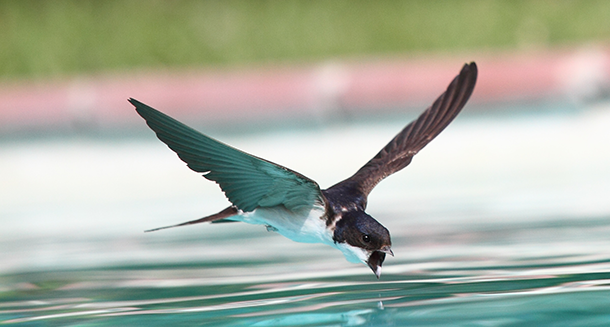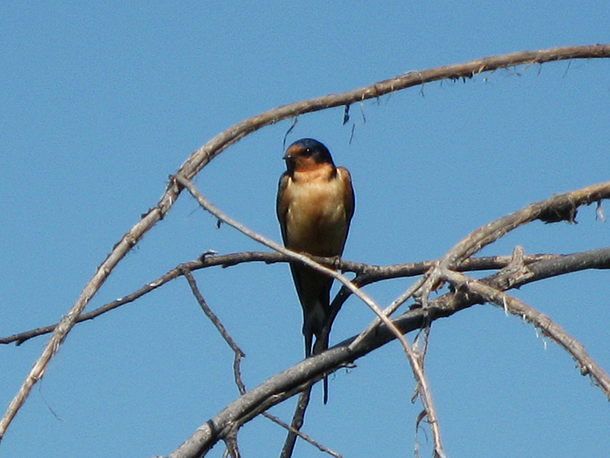BirdNote®: Drinking on the Wing
Air Date: Week of May 20, 2016

A tree swallow dipping down for a drink (Photo: Nicholas Sanchez, Creative Commons 2.0)
Most birds drink standing up, but swallows and swifts dip down over ponds to drink on the wing. In this week’s BirdNote® Michael Stein examines where this adaptation come from.
Transcript
BIRDNOTE®/DRINKING ON THE WING
[MUX - BIRDNOTE® THEME]
CURWOOD: As the days and evenings grow longer, and the weather entices us outside, the twittering of swifts and swallows overhead catches our ear. And as Michael Stein explains in this BirdNote®, if we pay close attention to them – we’ll notice something unusual.
BirdNote®
Drinking on the Wing
[Tree Swallow song, http://macaulaylibrary.org/audio/137594, 0.06-.10]
As a Tree Swallow swoops gracefully across a marsh, its long, slender wings glint a deep, iridescent blue. It glides close to the surface, tips its head down, and lightly skims the pond for a second with its beak open. Drinking – on the wing.
[Tree Swallow calls, http://macaulaylibrary.org/audio/94428]
Many birds drink while standing: dipping their beaks into a pond or birdbath, taking a beakful, and then tossing their heads back to swallow the water. And most birds can’t pull off a daredevil, in-flight drink because they just aren’t built for it. Swallows are such virtuosos of flight that their skimming the pond almost looks like showing off. [Tree Swallow calls, http://macaulaylibrary.org/audio/94428]
Drinking on the wing suits swallows best. They walk awkwardly on the ground on rather short legs, and their long wings are pretty cumbersome. So it’s far more efficient to grab a drink on the glide. This adaptation holds true for some other birds, too.

A barn swallow perched on a branch in Colorado (Photo: One Heart Art, Flickr CC BY-NC-ND 2.0)
[Common Nighthawk calls, http://macaulaylibrary.org/audio/516732]
Common Nighthawks are much bigger than swallows, with a two-foot wingspan. They take their water in flight, too. While swifts, with an even longer-winged structure than swallows, have such short legs that they never land on the ground, and so a sip on the wing is all but essential. I’m Michael Stein.
[Chimney Swift calls, http://macaulaylibrary.org/audio/5995, 0.07-.09]
###
Written by Bob Sundstrom
Bird sounds provided by The Macaulay Library of Natural Sounds at the Cornell Lab of Ornithology, Ithaca, New York. Tree Swallow [137594] recorded by Gerrit Vyn; Tree Swallow [94428] and Common Nighthawk [516732] recorded by W L Hershberger; Chimney Swift [5995] recorded by G B Reynard
BirdNote’s theme music was composed and played by Nancy Rumbel and John Kessler.
Producer: John Kessler
Executive Producer: Dominic Black
© 2016 Tune In to Nature.org May 2016 Narrator: Michael Stein
http://birdnote.org/show/drinking-wing
CURWOOD: For pictures, glide on over to our website, LOE.org.
Links
Living on Earth wants to hear from you!
Living on Earth
62 Calef Highway, Suite 212
Lee, NH 03861
Telephone: 617-287-4121
E-mail: comments@loe.org
Newsletter [Click here]
Donate to Living on Earth!
Living on Earth is an independent media program and relies entirely on contributions from listeners and institutions supporting public service. Please donate now to preserve an independent environmental voice.
NewsletterLiving on Earth offers a weekly delivery of the show's rundown to your mailbox. Sign up for our newsletter today!
 Sailors For The Sea: Be the change you want to sea.
Sailors For The Sea: Be the change you want to sea.
 The Grantham Foundation for the Protection of the Environment: Committed to protecting and improving the health of the global environment.
The Grantham Foundation for the Protection of the Environment: Committed to protecting and improving the health of the global environment.
 Contribute to Living on Earth and receive, as our gift to you, an archival print of one of Mark Seth Lender's extraordinary wildlife photographs. Follow the link to see Mark's current collection of photographs.
Contribute to Living on Earth and receive, as our gift to you, an archival print of one of Mark Seth Lender's extraordinary wildlife photographs. Follow the link to see Mark's current collection of photographs.
 Buy a signed copy of Mark Seth Lender's book Smeagull the Seagull & support Living on Earth
Buy a signed copy of Mark Seth Lender's book Smeagull the Seagull & support Living on Earth

